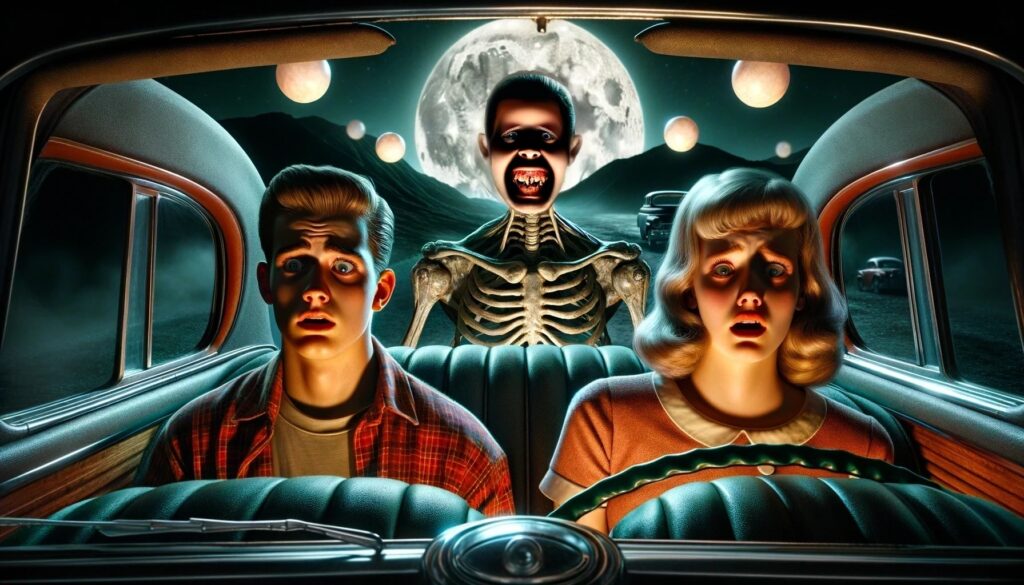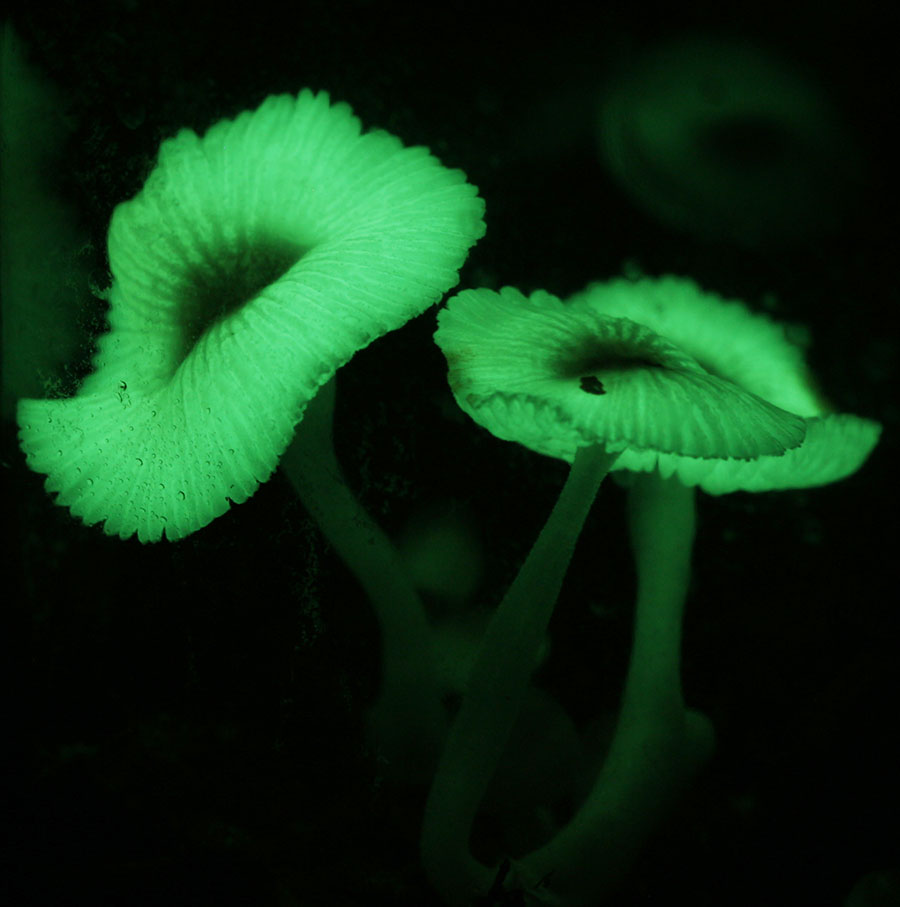Today, Becky tells us about the various theories behind the Brown Mountain Lights. To whet your appetite, she begins with the creepy Appalachian urban legend of Old Tom. Becky calls this boogeyman “the Freddy Krueger of Appalachia,” or the man with the skeleton body.
Hear theories behind the Brown Mountain Lights is on YouTube:
Or you can listen here:

What are the Brown Mountain Lights?
The Brown Mountain Lights are a series of mysterious and unexplained lights, observed near Brown Mountain in North Carolina. They have fascinated observers and perplexed scientists for over a century now. The mystery has given rise to numerous legends and theories about their nature and origins.
Where are the Brown Mountain Lights Located?
Brown Mountain is located in the Pisgah National Forest in western North Carolina, United States. This rugged area lies in the heart of the Blue Ridge Mountains, part of the larger Appalachian Mountains range. The mountain itself is located between the towns of Morganton and Linville. It is accessible via several routes, including North Carolina Highway 181 and the scenic Blue Ridge Parkway.
History of The Brown Mountain Lights
The first recorded sightings of the Brown Mountain Lights date back to the early 20th century. Additionally, local Native American tribes reportedly told legends involving the lights long before settlers arrived. The phenomenon typically appears at night as glowing orbs that can vary in color and size. There’s no shortage of theories about the nature of the lights. Yet, no single theory seems to hold up to scrutiny.
Cause of The Brown Mountain Lights Phenomenon: Theories
Swamp Gas
Theory: One common explanation is that the lights are caused by swamp gas. Decaying vegetation releases methane, which can spontaneously ignite when it comes into contact with oxygen, creating brief flashes of light.
Criticism: This theory, however, fails to hold up under scrutiny because Brown Mountain and its surrounding areas are not swampy. The terrain is rocky and forested, which is not conducive to the accumulation of large amounts of decaying vegetation needed to produce swamp gas.
Foxfire
Theory: A naturalistic explanation for the Brown Mountain Lights is the phenomenon known as “foxfire.” Foxfire is a bioluminescence produced by certain types of fungi on decaying wood. The mushrooms glow when enzymes in the fungi react with organic compounds, creating a soft glow.

Criticism: Foxfire is a well-documented natural occurrence. Unfortunately, the theory does not stand up well. Foxfire typically emits a very faint light and is usually only visible at very close range. The lights observed at Brown Mountain, on the other hand, are often reported as brightly visible from great distances. Additionally, the lights move around, much like mushrooms generally don’t.
Saint Elmo’s Fire
Theory: Saint Elmo’s Fire is an electro-luminescent plasma caused by a strong electric field in the atmosphere. This stormy weather-related phenomenon manifests as a glowing violet light. It usually appears on pointed objects such as ship masts, airplane wings, longhorns of cattle, or even mountain peaks.
Criticism: Saint Elmo’s Fire, while visually similar to descriptions of the Brown Mountain Lights, does not fully account for them. Saint Elmo’s Fire is directly tied to atmospheric electricity during storms. Thus it would not occur regularly in clear weather conditions. Yet the Brown Mountain Lights often appear in clear weather.
Moreover, this phenomenon clings to conductive surfaces. Saint Elmo’s Fire does not move through the air or across great distances like the Brown Mountain Lights do. These discrepancies make it an unlikely explanation.
Ball Lightning
Theory: Ball lightning is another scientific phenomenon often suggested as a potential explanation for the Brown Mountain Lights. People describe this atmospheric electrical phenomenon as luminescent, spherical objects that vary from pea-sized to several meters in diameter. Unlike typical lightning, it can last longer and move in various directions.
Criticism: Ball lightning itself is unexplained. The true nature of ball lightning remains largely mysterious, as scientists are still not entirely sure what causes it or how it works. While it could theoretically explain the lights’ erratic movements and luminous appearance, ball lightning is exceedingly rare and poorly understood.
Additionally, ball lightning is usually associated with stormy conditions, which is not a consistent factor in sightings of the lights. The duration and behavior of ball lightning vary, but typically last considerably shorter than the observations of the lights. Plus, it just feels lazy to explain a mystery using another inexplicable mystery, no?
Geologic Activity
Theory: The release of piezoelectric charges caused by quartz compression due to tectonic movements, is another suggested cause. Quartz is abundant in the Appalachian Mountains, and stress on these rocks could indeed release electrical charges.
Criticism: The geologic activity theory sounds promising, but struggles to explain the frequency and behavior of the lights. No significant correlation has been found between observed lights and seismic activity in the area. Moreover, piezoelectric effects typically do not produce lights as bright as those on Brown Mountain.
Atmospheric Reflections of Manmade Headlights
Theory: A very practical explanation for some sightings of the Brown Mountain Lights is that they could be the headlights reflecting off clouds, mist, or other surfaces. Certain atmospheric conditions might refract light from more mundane sources and project it onto the clouds or other surfaces. This was, oddly, the conclusion of the research conducted on the phenomenon in the 1920s. You’d think researchers from that time period would be especially aware that headlights were a fairly recent development.
Criticism: This theory could plausibly explain some instances where the lights appear to follow a linear, predictable path. Yet many reports of the lights describe erratic movements that do not align with the predictable paths of vehicles. For instance, the lights are often reported as hovering, darting, or ascending, quite unlike vehicle headlights. Additionally, sightings have been recorded from angles and locations where roads or tracks are not in direct line of sight. Most damningly, reports of the lights predate vehicle traffic in the region. The absence of train tracks on the mountain probably excludes trains as a direct source of the lights as well. Furthermore, the lights have been reported during various weather conditions when such reflections would be highly unlikely.
Hoax
Theory: A more skeptical view is that some or all of the sightings could be hoaxes. This theory suggests that individuals could be using artificial lights, such as lanterns or modern drones equipped with LEDs, to create the illusion of mysterious lights for various reasons, ranging from pranks to attracting tourists.
Criticism: The possibility of some instances being hoaxes could be true, especially in more recent times with the availability of technology. Yet this theory does not convincingly explain the sightings that date back to before such technology. Additionally, the widespread and consistent nature of the reports makes it unlikely that all observations could be attributed to hoaxes. Sightings have been reported by scientists and government officials. These credible witnesses are less likely to be deceived by or participate in a hoax.
Alien Activity
Theory: A more fringe theory is that the lights are related to alien activity. This theory is bolstered by stories of unexplained disappearances and UFO sightings in the vicinity of Brown Mountain. Could there possibly be a secret alien base under the mountain?
Criticism: The alien theory relies heavily on anecdotes and lacks substantial verifiable proof. Additionally, similar atmospheric phenomena observed worldwide have not been convincingly linked to extraterrestrial activity. There’s probably a lot we don’t know still about extraterrestrials. Hopefully someday soon we’ll know more, but for now the theory is unverifiable.
Spirit Orbs or Ghosts
Theory: Some local folklore suggests that the lights are spirit orbs of Cherokee spirits, particularly from the souls of women searching for loved ones lost in battle. Alternately, Becky proposes it might be the spirit of a woman who met a ghastly end on Brown Mountain.
Criticism: There is no universally agreed upon explanation of the exact nature of spirit orbs, making it a less provable explanation. If you’ve directly observed a spirit orb with your naked eye, did it behave this way?
Where to See the Brown Mountain Lights: Directions
Intrigued enough to seek out those enigmatic lights on your own? There are several popular viewing locations that offer a chance to witness the phenomenon. Here’s a map to the Brown Mountain overlook on North Carolina Highway 181; one of the most accessible spots, providing a clear view of the mountain where the lights are often seen. This overlook is located just north of Morganton, NC, and can be reached by a short drive from the city.
Another prime location for viewing the Brown Mountain Lights is the Wiseman’s View in Linville Gorge, a more rugged, scenic vantage point. To reach Wiseman’s View, visitors can follow the signs from NC Highway 183 to Old NC 105 and continue to the Wiseman’s View parking area; from there, a short paved trail leads to the overlooks. Additionally, the Blue Ridge Parkway offers a good viewpoint at milepost 301 (Green Mountain overlook), which are easily accessible by car and provide panoramic views of the area where the lights have been spotted.
How to See the Brown Mountain Lights
Unfortunately, you’re unlikely to see the lights while briefly standing at these locations and looking frantically for 15 minutes. For the best chance of seeing the lights, plan to spend the night somewhere you can watch for them for several hours. Visit on a clear, dark night, ideally around new moon phases when less moonlight is present to obscure the phenomenon.
Because you’re unlikely to see the lights for yourself without spending hours or even days gazing into the distance, why not double up on your road trip goals and hit up The Brown Mountain Lights Festival? This tongue-in-cheek, alien-themed music festival takes place each October in Morganton, NC.
Photos and Videos of the Brown Mountain Lights
Good photographs of the Brown Mountain Lights are hard to capture, given the nocturnal and fleeting nature of the phenomenon. Here’s a video of the lights that made the news back in 2016. We’ll try to get a photo of the mysterious lights for you on our upcoming trip to Appalachia.
